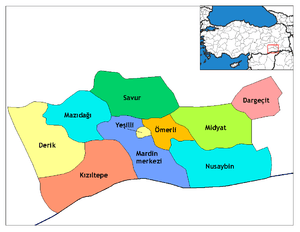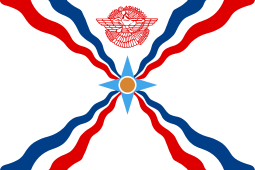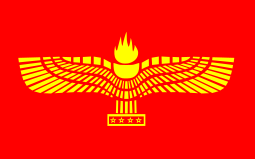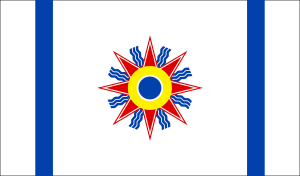Midyat
Midyat (Kurdish: Midyad[3] Syriac: ܡܕܝܕ Mëḏyaḏ[4], Turoyo: Miḏyoyo, Arabic: مديات) is a town in Mardin Province of Turkey. The ancient city is the center of a centuries-old Hurrian town in Southeast-Turkey. In its long history the city of Midyat has been ruled by various different leaders and nations. According to the 1960 population census Midyat was home to 570 christian households and only 30 muslim households.[5]
Midyat | |
|---|---|
 Mor Barsawmo Syriac Orthodox Church. | |
 Midyat | |
| Coordinates: 37°25′00″N 41°22′11″E | |
| Country | |
| Province | Mardin |
| Government | |
| • Mayor | Veysi Şahin (AKP) |
| • Kaymakam | Fatih Akkaya |
| Area | |
| • District | 1,054.25 km2 (407.05 sq mi) |
| Elevation | 953 m (3,127 ft) |
| Population (2012)[2] | |
| • Urban | 60,425 |
| • District | 105,542 |
| • District density | 100/km2 (260/sq mi) |
| Post code | 47500 |
| Website | www.midyat.bel.tr |
History
The history of Midyat can be traced back to the Hurrians during the 3rd millennium. Ninth century BC Assyrian tablets refer to Midyat as Matiate, or city of caves due to the caves at eleth 3 km away from the city where the earliest inhabitants lived. Many different empires had ruled over Midyat including the Mitannians, Assyrians, Armenians, Medes, Persians, Greeks, Romans, Byzantines, Abbasids, Seljuks and Ottomans.[6]
Demographics
Assyrian Population
Midyat is an historic center of the Assyrians in Turkey, and as late as the Assyrian genocide in 1915 they constituted the majority of the city's population. During the early 20th century, the Assyrian population of the city started to gradually diminish due to emigration, but the community was still very large. The Assyrians of Tur Abdin were the only significant population of Christians outside of Istanbul, until 1979, when panic ensued over an act war and an exodus of local Christians overtook the city as a result, because a Mayor and major Syriac figure in Turabdin of the city of Kerboran, now named Dargecit, was assassinated and replaced with a Kurdish representative against the peoples will. The Syriacs up until then had control over the local government, and could therefore unify to resist threats. Panic ensued as the local Muslim population made a symbolic declaration of war against the Syriac people and soon after the takeover, local Mhallami and Kurdish inhabitants started immigrating into the traditionally Syriac areas, causing a demographic shift which - along with the start of the Turkey-PKK conflict a few years later in 1984 - sounded a death toll to the community not only here, but in all of Tur Abdin. From a 1975 population of 50,000 comprising 10% of Mardin Province's demographic structure[7]: barely 2,000 were left by the end of the conflict in 1999.[8] Now only around 3-5,000 live in Tur Abdin, with the other 15-17,000 living in Istanbul and other still functioning Syriac Diocese like Adiyaman,[9] Harput, and Diyarbakir.
The churches and houses belonging to the Christians have been preserved although many of them are empty, with their owners living away in Europe. At present 500 Syriac Christians live in Midyat, and they have been joined by 1-300 Assyrian refugees fleeing the Syrian Civil War who have settled in the city and region according to different estimates,[10] and comprise 1% of the population of Midyat. There are 5 Churches in the city, and all are Syriac.[11][12]
Geography
The City has many distinguishable features which can make it easy to tell which areas are which. The city of Midyat is in fact two settlements- one to the east and one to the west. This is noticeable even today as the two old towns, and their clustered street plans, are very far apart, therefore showing that later on the area was connected to form a single united city when more buildings were built in between the two old towns. The Assyrian part of the city is in the east and the part of the city they live is distinguishable by the number of older buildings, churches, and amount of deterioration due to abandonment. Many buildings in the old towns are also distinguishable due to their ornate patterns and use of Midyat Limestone, although it is also used in a few of the newer buildings outside of the old town too. The Kurdish and Mhallami populated parts of the city are all of the buildings to the west of the Assyrian old town (which is the one that lies east). The entire region is divided East-West along those lines in fact, with most of the remaining Assyrian villages in Tur Abdin being no further west then Midyat is.
Quarters
During the late Ottoman period the city was divided up into different districts, still used in modern times. Old Midyat was divided into the following quarters (written in Syriac using the Latin alphabet: Aš šawṯawoṯo d Mëḏyaḏ):
- Qašrowat
- Halafe Abdike
- Barlaṭe
- Griġowat
- Baḥdowat
- Zatte Čalma
- Zabuq
- Malke Mire
- Ġannowat
- Sacidowat
- Čëfčaqa
Economy

Midyat is the regional center of commerce for the district, and is one of the largest cities in Mardin Province. Similarly with Mardin, The City is known for its Syriac handicrafts such as carpets, towels and other cloth goods. More specific to the city is its Syriac silver crafts called telkari, which are handcrafted filigreed ornaments. To the east of the city there is a winery that makes traditional Syriac wine: a wine native to the region. Another staple in the Midyat market is its bulgur, which is a cereal food derived from wheat.[13] Tourism in Midyat, however dwarfed it may be compared to Mardin, is still an important part of the economy as well, having several world class hotels such as the Schmayaa, Turabdin, Midyat, and Kasr-i Nehroz hotels.
Climate
Midyat, part of the province of Mardin, has a semi-arid climate with very hot and dry summers and cold, wet, and occasionally snowy winters. Temperatures in summer usually increase to 40 °C - 50 °C (104 °F - 122 °F) due to Mardin being situated right next to the border of Syria. Snowfall is quite common between the months of December and March, snowing for a week or two. Mardin has over 3000 hours of sun per year. The highest recorded temperature is +48.8 °C.
| Climate data for Mardin, Midyat | |||||||||||||
|---|---|---|---|---|---|---|---|---|---|---|---|---|---|
| Month | Jan | Feb | Mar | Apr | May | Jun | Jul | Aug | Sep | Oct | Nov | Dec | Year |
| Average high °C (°F) | 6.1 (43.0) |
7.5 (45.5) |
12.0 (53.6) |
17.7 (63.9) |
24.2 (75.6) |
30.9 (87.6) |
35.3 (95.5) |
34.9 (94.8) |
30.4 (86.7) |
23.1 (73.6) |
14.4 (57.9) |
8.2 (46.8) |
20.4 (68.7) |
| Daily mean °C (°F) | 3.1 (37.6) |
4.1 (39.4) |
8.2 (46.8) |
13.7 (56.7) |
19.7 (67.5) |
25.8 (78.4) |
30.0 (86.0) |
29.6 (85.3) |
25.2 (77.4) |
18.5 (65.3) |
10.7 (51.3) |
5.2 (41.4) |
16.1 (61.1) |
| Average low °C (°F) | 0.6 (33.1) |
1.3 (34.3) |
4.7 (40.5) |
9.9 (49.8) |
15.1 (59.2) |
20.2 (68.4) |
24.6 (76.3) |
24.6 (76.3) |
20.6 (69.1) |
14.6 (58.3) |
7.7 (45.9) |
2.7 (36.9) |
12.2 (54.0) |
| Average precipitation mm (inches) | 99.8 (3.93) |
110.7 (4.36) |
94.6 (3.72) |
75.5 (2.97) |
37.7 (1.48) |
8.3 (0.33) |
3.3 (0.13) |
1.2 (0.05) |
4.1 (0.16) |
33.3 (1.31) |
68.7 (2.70) |
104.2 (4.10) |
641.4 (25.24) |
| Average rainy days | 10.6 | 10.6 | 10.7 | 9.9 | 6.6 | 1.7 | 0.5 | 0.2 | 0.7 | 5.3 | 7.4 | 10.2 | 74.4 |
| Mean monthly sunshine hours | 139.5 | 142.8 | 189.1 | 222 | 310 | 375 | 396.8 | 368.9 | 315 | 238.7 | 174 | 136.4 | 3,008.2 |
| Source: Devlet Meteoroloji İşleri Genel Müdürlüğü | |||||||||||||
References:
Bargello, Fehmi, Min hemstad Midyat. Linköping: 2015.
Bargello, Fehmi, I flyktens kölvatten. Jönköping: 1998.
Hollerweger, Hans, Turabdin. Austria: 1999.
Gallery
 A picture of plants taken in old town that depicts the Droste effect
A picture of plants taken in old town that depicts the Droste effect Courtyard of the Kasr-i Nehroz hotel
Courtyard of the Kasr-i Nehroz hotel A statue of Mustafa Kemal Atatürk in Kardeşlik Park
A statue of Mustafa Kemal Atatürk in Kardeşlik Park- Midyat (2013): A picture of the Assyrian old town, taken from a rooftop in the southeastern part of the old town facing north.
- Panorama of the city of Midyat
- A mosque in Midyat
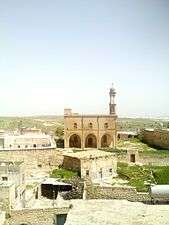 The Protestant Church of Midyat, located in old Midyat- pictured prior to its renovation in 2014/2015.
The Protestant Church of Midyat, located in old Midyat- pictured prior to its renovation in 2014/2015.
References
- "Area of regions (including lakes), km²". Regional Statistics Database. Turkish Statistical Institute. 2002. Retrieved 2013-03-05.
- "Population of province/district centers and towns/villages by districts - 2012". Address Based Population Registration System (ABPRS) Database. Turkish Statistical Institute. Retrieved 2013-02-27.
- Adem Avcıkıran (2009). Kürtçe Anamnez Anamneza bi Kurmancî (PDF) (in Turkish and Kurdish). p. 56. Retrieved 17 December 2019.
- Thomas A. Carlson et al., “Midyat — ܡܕܝܕ ” in The Syriac Gazetteer last modified January 14, 2014, http://syriaca.org/place/137.
- Bargallo, Fehmi (2015). Min Hemstad Midyat. p. 57.
- Emel Çelebi (September 1, 2001). "Midyat City of Stone". Christians of Iraq. Retrieved January 4, 2018.
- 530,000 people recorded in Mardin province census, 1975. Turabdin is mostly in Mardin province.
- "Turkey Destroys Assyrian Villages". Turkish Daily News. August 29, 1996. Retrieved January 4, 2018.
- "Mor Malki Ürek". soc-wus.org.
- "Syria's Assyrian Christians Find Refuge With Turkish Neighbours". Assyrian International News Agency. January 27, 2014. Retrieved January 4, 2018.
- Jimmy Jimmie (May 12, 2013). "The search for the 5 churches of Midyat". Traveling by default. Retrieved January 4, 2018.
- "Most Recent Things to Do in Midyat". March 28, 2013. Archived from the original on April 15, 2016. Retrieved January 4, 2018.
- "Midyat". Turkey from the Inside. Retrieved January 4, 2018.
External links
| Wikimedia Commons has media related to Midyat. |
